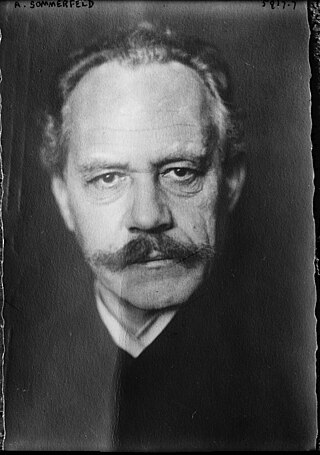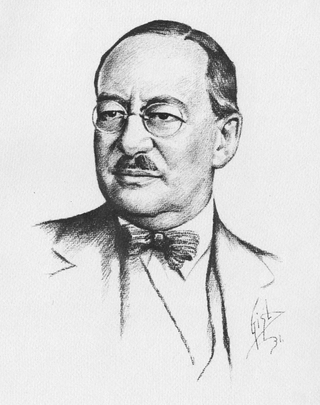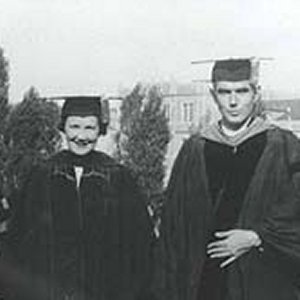
Arnold Johannes Wilhelm Sommerfeld, was a German theoretical physicist who pioneered developments in atomic and quantum physics, and also educated and mentored many students for the new era of theoretical physics. He served as doctoral supervisor and postdoc supervisor to seven Nobel Prize winners and supervised at least 30 other famous physicists and chemists. Only J. J. Thomson's record of mentorship offers a comparable list of high-achieving students.

In quantum physics and chemistry, quantum numbers are quantities that characterize the possible states of the system. To fully specify the state of the electron in a hydrogen atom, four quantum numbers are needed. The traditional set of quantum numbers includes the principal, azimuthal, magnetic, and spin quantum numbers. To describe other systems, different quantum numbers are required. For subatomic particles, one needs to introduce new quantum numbers, such as the flavour of quarks, which have no classical correspondence.

Albrecht Otto Johannes Unsöld was a German astrophysicist known for his contributions to spectroscopic analysis of stellar atmospheres.

Walter Heinrich Heitler was a German physicist who made contributions to quantum electrodynamics and quantum field theory. He brought chemistry under quantum mechanics through his theory of valence bonding.
Otto Laporte was a German-born American physicist who made contributions to quantum mechanics, electromagnetic wave propagation theory, spectroscopy, and fluid dynamics. His name is lent to the Laporte rule in spectroscopy and to the Otto Laporte Award of the American Physical Society.

Alfred Landé was a German-American physicist known for his contributions to quantum theory. He is responsible for the Landé g-factor and an explanation of the Zeeman effect.

Paul Sophus Epstein was a Russian-American mathematical physicist. He was known for his contributions to fluid dynamics and to the development of quantum mechanics.

Karl Ferdinand Herzfeld was an Austrian-American physicist.

LotharWolfgang Nordheim was a German-born Jewish American theoretical physicist. He was a pioneer in the applications of quantum mechanics to solid-state problems, such as thermionic emission, work function of metals, field electron emission, rectification in metal-semiconductor contacts and electrical resistance in metals and alloys. He also worked in the mathematical foundations of quantum mechanics, cosmic rays and in nuclear physics.
Erwin Richard Fues, was a German theoretical physicist who made contributions to atomic physics and molecular physics, quantum wave mechanics, and solid-state physics.
B. Adolf Kratzer was a German theoretical physicist who made contributions to atomic physics and molecular physics, and was an authority on molecular band spectroscopy. He was born in Günzburg and died in Münster.

Helmut Hönl was a German theoretical physicist who made contributions to quantum mechanics and the understanding of atomic and molecular structure.

Carl Henry Eckart was an American physicist, physical oceanographer, geophysicist, and administrator. He co-developed the Wigner–Eckart theorem and is also known for the Eckart conditions in quantum mechanics, the Eckart–Young theorem in linear algebra., and his work on non-equilibrium thermodynamics and continuum mechanics, including a relativistic treatment
Edwin Crawford Kemble was an American physicist who made contributions to the theory of quantum mechanics and molecular structure and spectroscopy. During World War II, he was a consultant to the Navy on acoustic detection of submarines and to the Army on Operation Alsos.

Karl Wilhelm Meissner was a German-American physicist specializing in hyperfine spectroscopy. He spent the greater part of his career in the United States at Purdue University, in West Lafayette, Indiana.

Otto Scherzer was a German theoretical physicist who made contributions to electron microscopy.
Fritz Eduard Josef Maria Sauter was an Austrian-German physicist who worked mostly in quantum electrodynamics and solid-state physics.
Friedrich Arnold "Fritz" Bopp was a German theoretical physicist who contributed to nuclear physics and quantum field theory. He worked at the Kaiser-Wilhelm Institut für Physik and with the Uranverein. He was a professor at the Ludwig Maximilian University of Munich and a President of the Deutsche Physikalische Gesellschaft. He signed the Göttingen Manifesto.

The Physical Principles of the Quantum Theory(German: Physikalischen Prinzipien der Quantentheorie publisher: S. Hirzel Verlag, 1930) by Nobel laureate (1932) Werner Heisenberg and subsequently translated by Carl Eckart and Frank C. Hoyt. The book was first published in 1930 by University of Chicago Press. Then in 1949, according to its copyright page, Dover Publications reprinted the "unabridged and unaltered" 1930's version.

Lectures on Theoretical Physics is a six-volume series of physics textbooks translated from Arnold Sommerfeld's classic German texts Vorlesungen über Theoretische Physik. The series includes the volumes Mechanics, Mechanics of Deformable Bodies, Electrodynamics, Optics, Thermodynamics and Statistical Mechanics, and Partial Differential Equations in Physics. Focusing on one subject each semester, the lectures formed a three-year cycle of courses that Sommerfeld repeatedly taught at the University of Munich for over thirty years. Sommerfeld's lectures were famous and he was held to be one of the greatest physics lecturers of his time.














